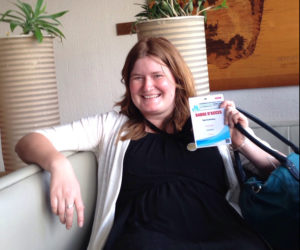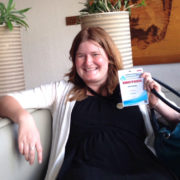Urban Adolescent Toolkit Presented at Madagascar’s First National Conference on Family Planning
Technical partners, donors and Ministry representatives gathered in Madagascar for a National Family Planning Conference from the September 13-16, 2016. The event in Antananarivo brought people together from across the island and served as a forum for the Ministry of Health to publicly present Madagascar’s commitment towards achieving the global FP2020 objectives. Throughout the four days, governmental and non-governmental entities presented their programs, lessons learned and strategies helping to achieve this objective.

Maia Freudenberger of Projet Jeune Leader shows off her conference badge at the Madagascar National Family Planning Conference. Photo Credit: Hariniaina Rasoazanany / Projet Jeune Leader.
Although the conference is officially over, I feel it is important today, on World Contraception Day, to reiterate the importance of creating strong and effective social and behavior change communication (SBCC) programs in the field of reproductive health and family planning – especially those that are geared towards youth and/or adolescents.
As the executive director of Projet Jeune Leader, a youth-led and youth-focused organization in Madagascar, I presented twice at the conference; once to showcase our core program, and also to present the Health Communication Capacity Collaborative’s (HC3) Urban Adolescent Sexual and Reproductive Health SBCC Implementation Kit (I-Kit) and to share our experiences using it. Projet Jeune Leader was selected as one of two pilot partners in Madagascar to test the I-Kit and provide feedback on the successes and challenges faced during its use (which I wrote about in this post.)
Both presentations generated great interest. Projet Jeune Leader was one of the few regional and one of the few youth-led organizations present at the conference. Our school-based reproductive health and leadership program to address the needs of young adolescents – the parents’ curriculum which was developed with the help of HC3’s I-Kit – was applauded as innovative and important.
The presentation on the I-Kit itself was equally well-received. Provided was an overview on the I-Kit’s format, its objectives, its target audience, and, most importantly, its application in the Madagascar context. I shared Projet Jeune Leader’s experience using the I-Kit and recommended it to the audience. A few attendees had participated in HC3’s 2014 I-Kit pretest sessions and therefore were familiar with the resource. However, the I-Kit, was new to the majority of participants. USAID/Madagascar also graciously publicized the I-Kit via promotional HC3 postcards at their conference booth.
The I-Kit has a role in creating such programs. It is a strong tool to help organizations – especially organizations with limited formal expertise in the field of SBCC – to craft new programs, to re-assess current ones, or to begin thinking of new approaches to most effectively reach out to populations about family planning and reproductive health rights, information and services. I would recommend that other organizations that have used the I-Kit should spread the word about this tool. This does not have to happen at a national level; in fact, I feel that the I-Kit can best serve regional or local organizations like Projet Jeune Leader that have an identified need and are open to new tools to build their SBCC program design capacity.








Leave a Reply
Want to join the discussion?Feel free to contribute!